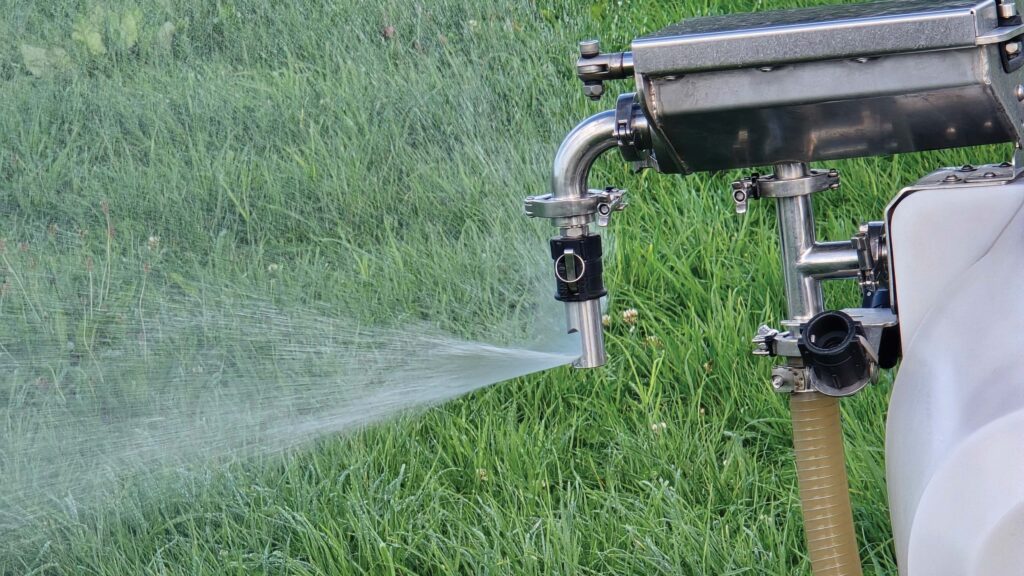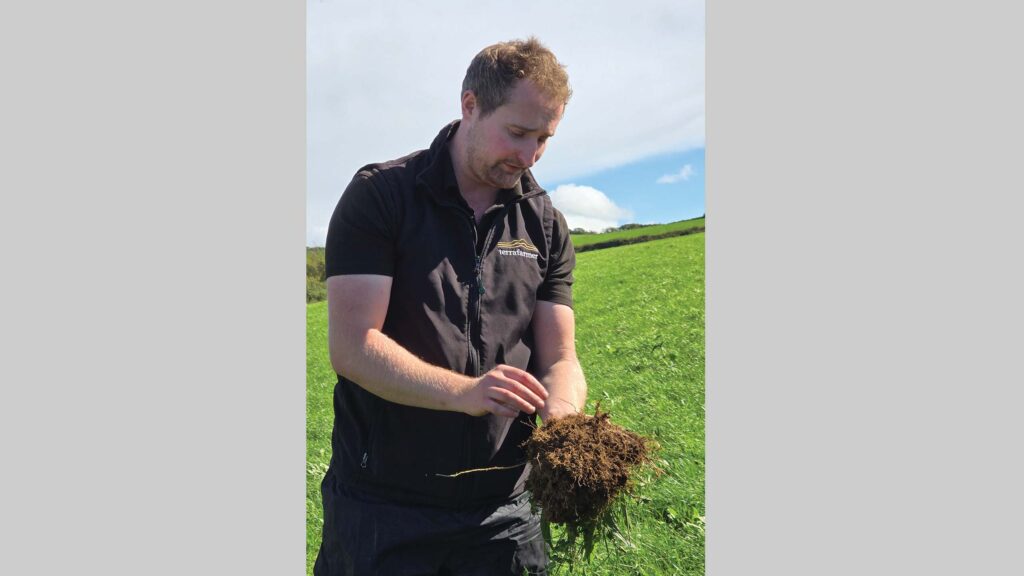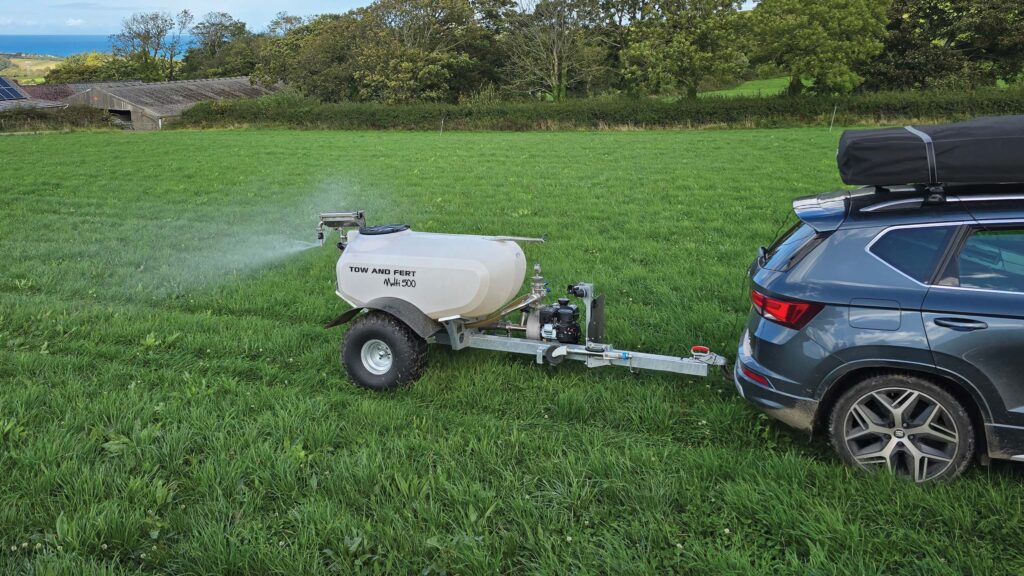Biological stimulants: Are they good for grassland?
 © MAG/Anne Dunn
© MAG/Anne Dunn Trials in Wales comparing a range of biological stimulants applied to grassland have shown their potential to reduce inputs and improve grass quality.
Results so far show an increase in kilograms of dry matter (DM)/ha, crude protein, trace element availability and microbial biomass from some of the six products tested, when compared with a control.
See also: How foliar feeding maintained grass growth at half N rate
This is according to regenerative agronomist and soil consultant Will Marris at Terrafarmer, which is running the nine-month, Innovate UK-funded research project.
“The seaweed-based products seem to be improving crude proteins and sugars,” he explains
“If that goes into a silage clamp, you’ve got more sugars for the fermentation process. If you get a better fermentation, you get better-quality forage.” (See graphs.)
Some products are also improving soil biology.
“The bacterial and fungal-type products are helping mobilisation of trace minerals such as boron, manganese and magnesium,” he says.
He adds that soil, leaf and forage tests show more of those nutrients moving from the soil into the leaf, and therefore into the forage.
This could reduce the need to supplement trace minerals given to livestock through licks or drenches, he suggests.
However, he adds that in some cases, when used in combination, the products have reduced microbial biomass, DM content and biomass yield.
How biological stimulants work
Traditional fertilisers such as urea or ammonium nitrate prills have an efficiency rate of about 50%, says Will.
By contrast, solubilised and foliar-applied alternatives can be almost twice as efficient, so less nitrogen is needed.
“If foliar nitrogen is applied with biologicals such as molasses, fish hydrolysate and fulvic acid, nitrogen use efficiency is improved, as you’re applying plant-available nitrogen to the leaf, which is a more direct route into the plant.

Will Marris © MAG/Anne Dunn
“That’s safer for the plant, but also beneficial and safer for the soil,” he says.
“You’re feeding the plant and the soil at the same time, and the nitrogen doesn’t get lost via volatilisation or tied up in the carbon and nitrogen cycles in the soil.”
He adds that by applying biological and soluble fertilisers, farmers can build soil function and fertility, carbon and organic matter, all generally at reduced cost.
“Biologicals are inherently more sustainable than a manufactured nitrogen source. We’re not saying don’t use any, just try to use a bit less and make it more efficient,” he says.
Cost savings
Using biological and foliar fertilisers can also bring significant cost savings, Will explains. For example, a grass-based, multicut system might use 250kg/ha of nitrogen.
Based on a standard urea application, using a 46% urea product, at a cost of 46p/kg, the cost would be £115/ha.
“Where we have added in two biological products, molasses and a fish hydrolysate, to the foliar nitrogen mix, we had a saving of £5/ha,” he says.
“A total cost of £110/ha to get a more efficient form of nitrogen into the plant, while reducing nitrogen use by 20%, is quite significant – and you’re feeding the soil.”
He adds that nitrogen application rates can, over time, be reduced even further.
“You could easily reduce inputs starting at 25% to 50%, but that wants to be done over a few years in a managed reduction,” he advises.
In addition, there is the potential for farmers to save on inputs such as mineral supplements because of the improved flow of nutrients from soil to forage.
“Hopefully, overall, there are fewer inputs in terms of vets, meds and additives in the feed,” he says.
Timing of application
The time of day and weather conditions make a significant difference to the effectiveness of biologicals and foliar nitrogen, Will says.
“If you’re looking at foliar nitrogen plus biologicals, it’s important to time your application right.
“Early in the morning or late at night is a good time, because that’s when the stomata are open,” he says.

Spraying with the Tow and Fert © MAG/Anne Dunn
He adds that in the morning especially, the plant will not be overly stressed, so is better at taking in the product, leading to greater efficiencies.
While temperature is an important consideration, UV index and humidity should be considered first when applying biological fertilisers and foliar applications, says Will.
“When you have a high UV index, the plant is conserving moisture and it’s not going to want to take in any nutrition.
“So the biological fertiliser or soluble nitrogen will sit on the leaf and can scorch or burn it, particularly if you’ve got urea in there.
“It’s best to apply these when the UV index is low and humidity is high. Humidity means moisture and that means stomata are open to take in these products,” he explains.
Will says that for optimum effectiveness, a large droplet of product needs to hit the leaf, to spread and then be absorbed.
“In a perennial grassland system, you generally have more cover than in an arable context, but the bigger, broader the leaf, the better.
“You can pre-treat and apply before a grazing cycle or afterwards, when there’s enough regrowth for the leaf to take it in efficiently.”
Application should be timed to work around grazing cycles: 20 to 30 days is generally about right. However, little and often is always better, he recommends.
Choice of product
Before deciding which products to buy, Will says it is important to get a thorough baseline analysis of the soil and plant elements.
“If you get a baseline, you know what potentially is deficient and you can select your products accordingly and ultimately save money,” he says.
For those who are sceptical, he advises starting small and giving the products a chance to work.
“Take a bit of time to read the data and understand what each product is trying to do, and pick it for that purpose,” he says.
Biological products tested
- Soil Point Humic- and fulvic-based soil conditioner to provide trace minerals
- Sea2Soil Fish protein hydrolysate delivering plant-available amino acids and trace elements to the crop and soil
- Slygen Mix of 18 beneficial rhizobacteria and fungi
- Kelp Crofters Seaweed- and kelp-based biological input containing auxins, cytokinins and gibberellins
- QLF TerraFed Filtered molasses delivering sugars to plants and soil microbiology
- Biocat Novel phage technology targeting harmful soil bacteria.
Trial method
Data are being collected on the use of six biological inputs on four farms through Innovate UK and three additional farms through Farming Connect.
Each has eight trial plots (20x160m), with products applied using a Tow and Fert machine and timed around grazing and cutting regimes.
The first application was made in mid-May, and a second in mid-July. The products were applied individually and in combination, with a control plot.
Each plot received two applications of the products, and data were collected at three GPS sample points, yielding a total of 24 data points from each farm.
Leaf, forage and biomass data were collected two to three weeks after product application.
A soil sample baseline was taken before any application. Further samples were taken two to three weeks after each application.
